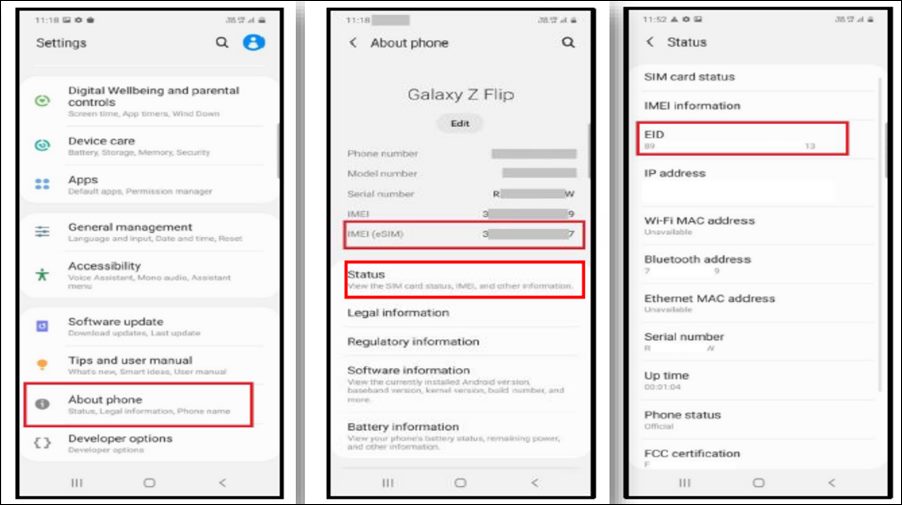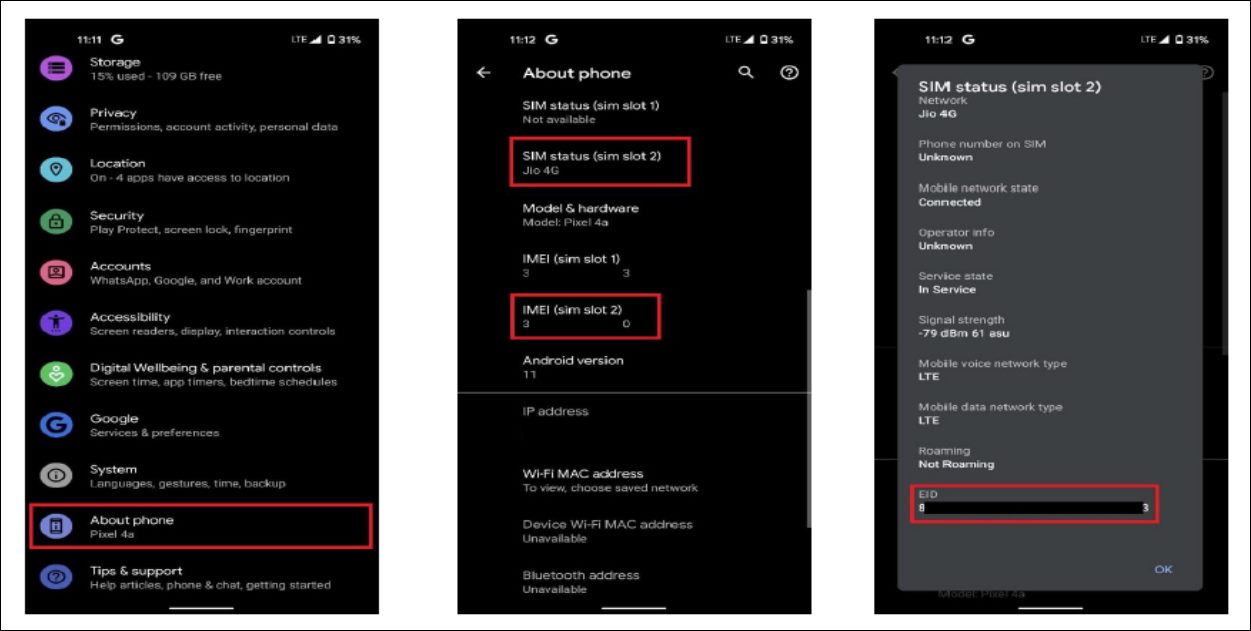In this article, you will learn:
- The EID (Embedded SIM Identifier) number is a unique 32-digit identifier associated with eSIMs in modern devices, playing a pivotal role in eSIM management.
- eSIM technology offers unparalleled convenience and flexibility, allowing users to switch carriers and manage their mobile plans without physically swapping SIM cards.
- To find your EID number, you can navigate to the “Settings” app on your smartphone and look for sections like “About Phone” or “eSIM.” The exact steps may vary depending on the device make and model.
- eSIM technology and EID numbers come with robust security features, including encryption, authentication, remote management, and physical security, ensuring the protection of user data and secure communication.
- The adoption of eSIM technology is on the rise, transforming the way devices connect and offering users enhanced flexibility and security.
Have you ever wondered about the unique 32-digit identifier on your smartphone? In the age of eSIM technology, understanding the intricacies of our devices is more crucial than ever. The EID (Embedded SIM Identifier) number, a pivotal component of eSIM management, is transforming the way we connect. Recent data suggests that the adoption of eSIM technology is on the rise, offering unparalleled convenience and flexibility. But with this evolution comes questions: How do you find your EID number? Why is it so vital? Dive into this article to uncover the significance of EID numbers, empathize with the common challenges users face, and discover unique insights that you won’t find elsewhere. Optimized for both search engines and mobile readers, we ensure a seamless reading experience.

This image is property of droidwin.com.
What is EID Number?
An EID (Embedded SIM Identifier) number is a unique 32-digit identifier associated with eSIMs found in modern smartphones, wearables, and other connected devices. The eSIM, short for embedded SIM, is a tiny, electronic version of the traditional SIM card, which is soldered directly onto a device’s motherboard. The EID number serves as a crucial component for eSIM management, allowing mobile network operators to remotely provision and manage the eSIM profiles on a device.
How Can You Find Your EID Number?
Locating your EID number may vary depending on the make and model of your smartphone. However, there are general steps you can take to find your EID number on most devices.
Steps to Find Your EID Number on Most Devices
- Navigate to the “Settings” app on your smartphone.
- Scroll down and select “About Phone” or “About Device.”
- Look for a section named “eSIM” or “SIM Card & Mobile Networks.”
- Within this section, you should see an option labeled “EID” or “Embedded SIM Identifier.”
- Tap on this option, and your 32-digit EID number should be displayed.
Steps to Find Your EID Number on iPhone
If you have an iPhone, the process to find your EID number is slightly different. Here are the steps you can follow:
- Open the “Settings” app on your iPhone.
- Tap on “General.”
- Select “About.”
- Scroll down until you find the “EID” section.
- Your 32-digit EID number should be displayed.
If you are unable to locate your EID number using these methods, you can consult your device’s user manual or contact your device manufacturer for assistance.

This image is property of en.tab-tv.com.
Consulting Your Device’s User Manual or Manufacturer
If the general steps mentioned above do not help you find your EID number, consulting your device’s user manual or contacting your device manufacturer is a good option. The user manual will provide specific instructions tailored to your device, ensuring that you can locate your EID number accurately.

This image is property of droidwin.com.
Security of EID Numbers
eSIM technology and EID numbers come with several security features that are designed to protect user data and ensure secure communication. These security measures play a crucial role in maintaining the integrity and confidentiality of the eSIM profiles. Here are some of the security aspects associated with EID numbers:
Encryption
Communication between the device and the carrier during the provisioning process is encrypted. This ensures that the data exchanged is secure and cannot be intercepted by unauthorized parties. The encryption protocols used in eSIM technology are robust and reliable, providing a high level of protection for user data.
Authentication
eSIMs use authentication protocols to verify the identity of the device and the network. This prevents unauthorized devices from connecting to the network and ensures that the eSIM is only used in the intended device. By implementing strong authentication mechanisms, the security of the eSIM profiles is enhanced, reducing the risk of unauthorized access.
Remote Management
The ability to remotely manage eSIM profiles through EID numbers allows for better security control. For example, if a device is lost or stolen, the eSIM profile can be remotely deactivated. This prevents unauthorized use of the eSIM and protects sensitive data. Remote management also enables mobile network operators to update security features on eSIM profiles, ensuring that they remain protected against emerging threats.
Physical Security
Since eSIMs are soldered directly onto the device’s motherboard, they are less susceptible to physical tampering compared to traditional SIM cards. This physical security feature adds an extra layer of protection to the eSIM profiles, making it harder for attackers to access or manipulate the eSIM. The robust physical design of eSIMs ensures the integrity and confidentiality of the stored data.
In conclusion, EID numbers play a critical role in eSIM technology, allowing users to switch carriers and manage their mobile plans seamlessly. The security measures associated with EID numbers, such as encryption, authentication, remote management, and physical security, ensure the protection of user data and secure communication. By understanding the importance of the EID number and knowing how to locate it on your smartphone, you can enjoy the convenience and flexibility that eSIM technology offers.
Frequently Asked Questions
What is an EID number?
An EID (Embedded SIM Identifier) number is a unique 32-digit identifier associated with eSIMs in modern devices.
How is an eSIM different from a traditional SIM card?
An eSIM is an electronic version of the traditional SIM card, which is soldered directly onto a device’s motherboard, eliminating the need for a physical card.
How can I find my EID number on my smartphone?
You can typically find your EID number in the “Settings” app of your smartphone, under sections like “About Phone” or “eSIM.” The exact path may vary depending on the device make and model.
Are EID numbers secure?
Yes, EID numbers and eSIM technology come with several security features, including encryption, authentication, and remote management, to protect user data and ensure secure communication.
What are the benefits of using eSIM technology?
eSIM technology offers users the flexibility to switch between carriers and plans without physically swapping SIM cards. It also provides enhanced security features compared to traditional SIM cards.




